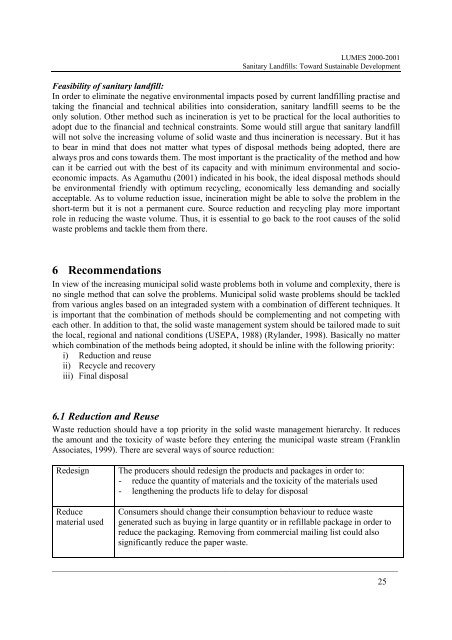Sanitary Landfills: Toward Sustainable Development - lumes
Sanitary Landfills: Toward Sustainable Development - lumes
Sanitary Landfills: Toward Sustainable Development - lumes
You also want an ePaper? Increase the reach of your titles
YUMPU automatically turns print PDFs into web optimized ePapers that Google loves.
LUMES 2000-2001<br />
<strong>Sanitary</strong> <strong>Landfills</strong>: <strong>Toward</strong> <strong>Sustainable</strong> <strong>Development</strong><br />
Feasibility of sanitary landfill:<br />
In order to eliminate the negative environmental impacts posed by current landfilling practise and<br />
taking the financial and technical abilities into consideration, sanitary landfill seems to be the<br />
only solution. Other method such as incineration is yet to be practical for the local authorities to<br />
adopt due to the financial and technical constraints. Some would still argue that sanitary landfill<br />
will not solve the increasing volume of solid waste and thus incineration is necessary. But it has<br />
to bear in mind that does not matter what types of disposal methods being adopted, there are<br />
always pros and cons towards them. The most important is the practicality of the method and how<br />
can it be carried out with the best of its capacity and with minimum environmental and socioeconomic<br />
impacts. As Agamuthu (2001) indicated in his book, the ideal disposal methods should<br />
be environmental friendly with optimum recycling, economically less demanding and socially<br />
acceptable. As to volume reduction issue, incineration might be able to solve the problem in the<br />
short-term but it is not a permanent cure. Source reduction and recycling play more important<br />
role in reducing the waste volume. Thus, it is essential to go back to the root causes of the solid<br />
waste problems and tackle them from there.<br />
6 Recommendations<br />
In view of the increasing municipal solid waste problems both in volume and complexity, there is<br />
no single method that can solve the problems. Municipal solid waste problems should be tackled<br />
from various angles based on an integraded system with a combination of different techniques. It<br />
is important that the combination of methods should be complementing and not competing with<br />
each other. In addition to that, the solid waste management system should be tailored made to suit<br />
the local, regional and national conditions (USEPA, 1988) (Rylander, 1998). Basically no matter<br />
which combination of the methods being adopted, it should be inline with the following priority:<br />
i) Reduction and reuse<br />
ii) Recycle and recovery<br />
iii) Final disposal<br />
6.1 Reduction and Reuse<br />
Waste reduction should have a top priority in the solid waste management hierarchy. It reduces<br />
the amount and the toxicity of waste before they entering the municipal waste stream (Franklin<br />
Associates, 1999). There are several ways of source reduction:<br />
Redesign The producers should redesign the products and packages in order to:<br />
- reduce the quantity of materials and the toxicity of the materials used<br />
- lengthening the products life to delay for disposal<br />
Reduce<br />
material used<br />
Consumers should change their consumption behaviour to reduce waste<br />
generated such as buying in large quantity or in refillable package in order to<br />
reduce the packaging. Removing from commercial mailing list could also<br />
significantly reduce the paper waste.<br />
______________________________________________________________________________<br />
25

















